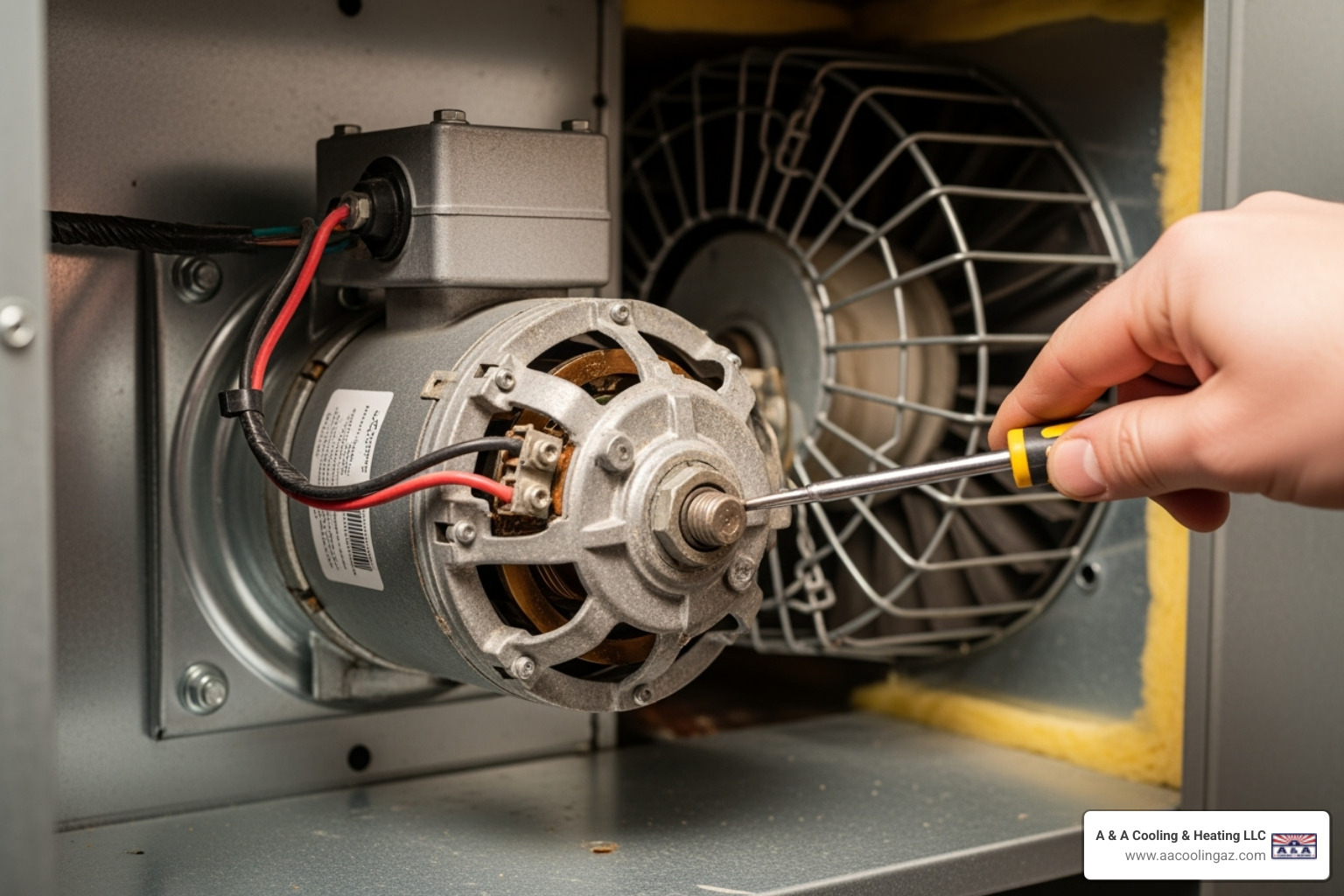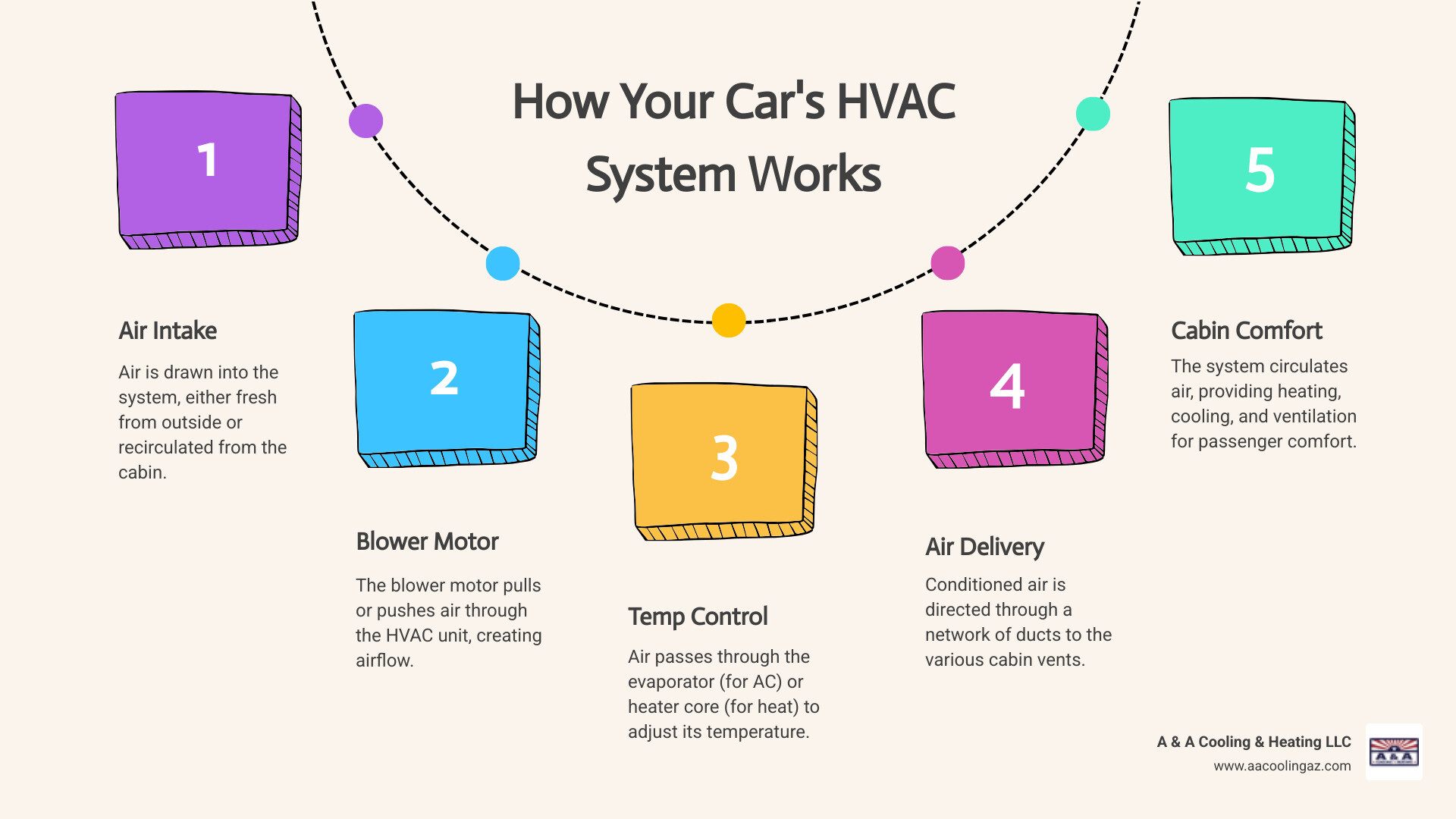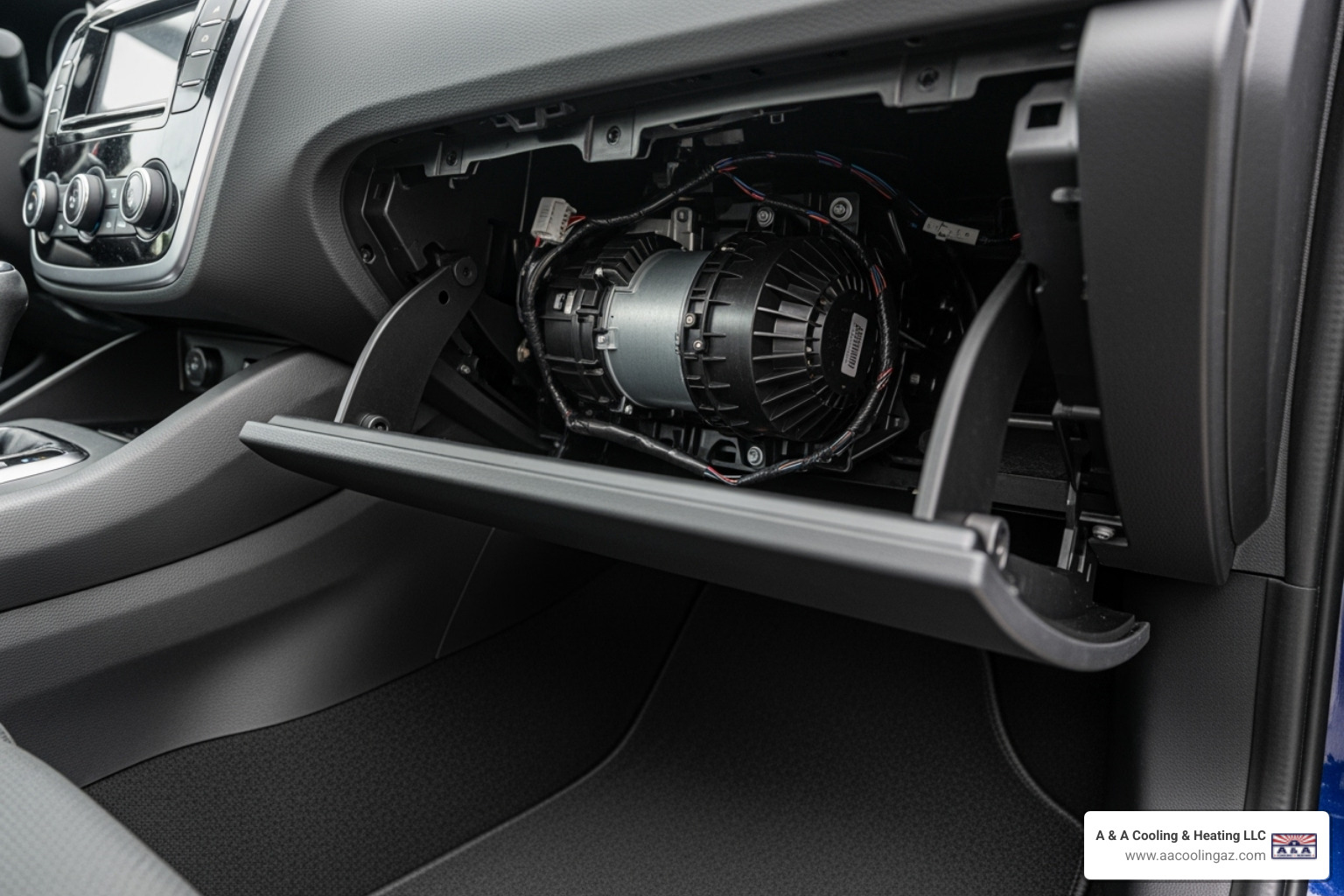Don't Get Blown Away: Your Guide to Replacing a Blower Motor

Why Your Blower Motor is Critical for Home Comfort
Blower motor replacement is essential when your heating and cooling system stops circulating air properly. The blower motor is the powerful fan that moves heated or cooled air through your ductwork and into every room of your house.
Quick Answer for Blower Motor Replacement:
- Symptoms - Weak airflow, unusual noises, or no air circulation.
- Location - Usually in the air handler or furnace unit.
- Time - 1-3 hours for professional replacement.
- Tools Needed - Socket set, screwdrivers, multimeter.
- Safety - Turn off power at the circuit breaker before starting.
- When to Call a Pro - Complex electrical work or warranty concerns.
Your heater, air conditioner, and ventilation system all depend on this single component. When it fails, you might notice some rooms are too hot or cold, strange grinding or squealing sounds from your vents, or a complete loss of airflow.
As one homeowner described their failing blower motor: "It sounded like a small jet was warming up in our vents!" These motors typically last 10-20 years, but Arizona's extreme temperatures can put extra stress on all HVAC components.
A failing blower motor doesn't just affect comfort; it can strain other parts of your system and increase energy bills. Understanding when and how to replace it can save you from more expensive repairs.

Is Your Blower Motor Failing? Common Symptoms to Watch For
Your home's HVAC system works hard to keep you comfortable, especially during Arizona's scorching summers and chilly winter mornings. When something goes wrong, the blower motor is often the culprit. This component pushes conditioned air through your vents, and when it starts failing, you'll notice.
A failing blower motor usually gives warning signs before it quits. Let's review the most common symptoms so you can spot trouble early.
Weak airflow is often the first sign. You feel only a whisper of air from the vents, even when the system is running. This happens when the motor can't spin fast enough to move the proper volume of air.
Even more frustrating is no airflow at all. The system turns on, but you feel nothing from the vents. This can mean the motor has failed completely, but it could also be a related part like a faulty capacitor or control board.
Your ears can also detect trouble. A healthy blower motor runs with a smooth, quiet hum. When you start hearing unusual noises, it's time to pay attention. Squealing or grinding sounds usually mean the motor's bearings are wearing out after thousands of hours of use.
A loud bang or clunk when the system starts or stops can indicate a problem with the motor or the fan wheel (also called a squirrel cage) attached to it.
An unusually high energy bill can also be a symptom. A struggling motor has to work harder and draw more electricity to do its job, which you'll see on your monthly statement.
Finally, if your system shuts off unexpectedly, it could be the motor overheating and tripping a safety switch. This is a clear sign that the component is under severe strain.
Why these symptoms occur

Understanding the cause helps determine if you need a blower motor replacement or a simpler fix.
Worn motor bearings are the most common reason for squealing, grinding, and eventual failure. These parts allow the motor's shaft to spin smoothly. Over time, they wear down, create friction, and can seize up.
Debris in the fan cage can cause imbalance, vibrations, and noise. Dust and other small items can get past a dirty air filter and build up on the fan blades, sometimes jamming it completely.
A failing run capacitor is another common issue. This component provides the extra electrical jolt needed to start and run the motor. When it fails, the motor may hum but not spin, or it may not start at all.
Electrical issues like loose connections, burnt wires, or a faulty control board can mimic motor problems. These issues can cause intermittent operation or complete failure and require careful diagnosis.
The key is recognizing these symptoms early. The sooner you address blower motor problems, the better your chances of avoiding a complete system failure when you need your HVAC most.
Gearing Up: Tools, Parts, and Safety Precautions
Preparing for a blower motor replacement means having the right tools and parts. A smooth job depends on good preparation.
For your tool arsenal, a socket set and both Phillips and flathead screwdrivers are essential for removing service panels and motor mounts. Pliers, especially needle-nosed ones, are helpful for disconnecting wiring harnesses. A good flashlight or headlamp is non-negotiable, as air handlers are often in dark closets, attics, or basements.
To confirm the motor is the problem, a multimeter is a smart tool to have. It can test for electrical power and check other components like the capacitor. You will also need the correct replacement motor for your specific HVAC unit. Check the part number on the old motor to ensure you get an exact match.
Essential safety steps before you begin
Safety is critical when working with your home's electrical systems. These steps are requirements, not suggestions.

Turning off power at the circuit breaker is the most important step. Locate the breaker for your furnace or air handler in your home's electrical panel and switch it to the "off" position. Use your multimeter to confirm there is no power at the unit before you touch any wires. Many HVAC units also have a secondary power switch located on or near the unit itself; turn this off as well.
Wear safety glasses and gloves. Protect your eyes from falling dust and debris, and protect your hands from sharp sheet metal edges inside the unit.
Ensure you have a stable work area. If your unit is in an attic or crawlspace, make sure you have safe, stable footing and adequate lighting.
With the right tools, the correct part, and a safety-first approach, you're setting yourself up for a successful blower motor replacement project.
A Step-by-Step Guide to Your Blower Motor Replacement
Ready to tackle that blower motor replacement? With your tools gathered and safety precautions in place, it's time to restore your home's comfort system. Every HVAC unit is different. While this is a general guide, consult your owner's manual for specifics about your model.
Step 1: Locate the Blower Motor Assembly
First, we need to find the motor. In most homes, the blower motor is located inside the furnace or air handler cabinet. This is typically in a utility closet, basement, garage, or attic.

After shutting off all power, you'll need to remove the service panel on the cabinet to access the internal components. This panel is usually held in place by a few screws or clips. Once inside, you will see the blower assembly—a large, hamster-wheel-like fan (the squirrel cage) attached to the motor. The entire assembly is often mounted on rails so it can be slid out for service.
Take a moment to study how everything is connected. You'll see the motor, the fan housing, and the wires leading to the control board. Taking a photo with your phone before you disconnect anything is a great way to ensure everything goes back correctly.
Step 2: Disconnect and Remove the Old Motor
Now it's time to remove the old motor. Work slowly and methodically.
Start by disconnecting the electrical wires from the motor to the control board. These are often color-coded, but your photo will be your best guide. Next, you'll need to remove the mounting screws or bolts that hold the entire blower assembly in the cabinet. Carefully slide the assembly out of the air handler.
With the assembly out, you can access the motor itself. You'll need to loosen the set screw on the motor shaft that holds the squirrel cage fan in place. Then, unbolt the motor from its mounting bracket. The motor can be heavy, so be prepared to support its weight as you remove the final bolt.
Before installing the new motor, inspect the area for debris. This is the perfect time to clean the fan cage and the blower housing with a brush and vacuum. A clean fan operates more efficiently and quietly.
Step 3: Install the New Blower Motor
Installation is the reverse of the removal process.
Mount the new motor onto the bracket, ensuring it's securely bolted. Slide the squirrel cage fan back onto the new motor's shaft and tighten the set screw firmly on the flat part of the shaft. Make sure the fan is centered in the housing and spins freely without rubbing.
Slide the entire assembly back into the air handler cabinet and secure it with its mounting screws. Reconnect the wiring according to your photos or the unit's wiring diagram. Ensure all connections are secure.
Before replacing the service panel, it's time for a crucial test. Go back to the breaker, restore power, and turn your thermostat on to activate the fan. Check that the motor runs smoothly and quietly. If everything works correctly, turn the power off again at the breaker, reinstall the service panel, and then restore power for the final time.
You've just completed a blower motor replacement and restored your home's airflow!
DIY vs. Professional Service: Making the Right Choice
Now for the big question: should you tackle this blower motor replacement yourself, or call a professional? There's no single right answer; it depends on your skills, tools, and the complexity of your system.
Before you begin, honestly assess your comfort level. Are you familiar with basic hand tools and electrical safety? The difficulty of this job varies. Some blower motors are easy to access, while others are tucked away behind complex components.
Time is another factor. A job that takes an experienced technician an hour could become a multi-hour project for a DIYer, especially if unexpected issues arise.
Considerations for a DIY blower motor replacement
Saving on labor costs is the biggest motivator for a DIY repair. You'll also gain a better understanding of your HVAC system, which can be an educational experience. If you have the part and tools ready, you can often complete the repair on your own schedule.
However, there are potential complications. You might encounter hard-to-reach fasteners or deal with complex wiring that doesn't match online diagrams. Mishandling components can also lead to more significant damage, turning a straightforward repair into a more expensive problem.
When to seek a professional for your blower motor replacement
Sometimes, the smartest decision is to call a professional. Modern HVAC systems can have complex electronics and variable-speed motors that require specialized knowledge to diagnose and replace correctly. Attempting a repair without the right expertise can cause costly damage to the control board.
If you lack the tools or confidence, it's wise to call for service. A botched DIY job often costs more to fix than the original professional repair would have.
What if you replace the motor and the fan still doesn't work? This points to a deeper issue, such as a bad capacitor, a faulty control module, or a thermostat problem. A professional has the diagnostic equipment to identify the real culprit quickly.
For peace of mind and a repair done to industry standards, professional service is the best choice. Most reputable shops provide warranties on their work, protecting your investment.
At A & A Cooling & Heating LLC, we've helped Apache Junction residents with their heating and cooling needs since 1976. We can help you determine the best course of action for your situation, saving you time, money, and frustration.
Frequently Asked Questions about Blower Motors
Over our decades of service in Apache Junction, we've heard just about every blower motor replacement question. Here are answers to the most common ones.
What is the average lifespan of a home's blower motor?
Under normal conditions, a home blower motor can last 10 to 20 years. However, in Arizona, our HVAC systems work overtime. This constant use, combined with dust, can shorten a motor's lifespan.
Regular maintenance is the best way to extend its life. The most important task is to change your air filter regularly. A clogged filter restricts airflow, forcing the motor to work harder and run hotter, which leads to premature wear on its bearings and windings.
What does the run capacitor do?
Many blower motors use a run capacitor to operate. Think of it as a small battery that gives the motor the electrical boost it needs to start spinning and helps it run efficiently. It's a small cylindrical component usually mounted on or near the blower housing.
A failing capacitor is one of the most common reasons a blower motor stops working. You might hear the motor hum or buzz without spinning, or it may not start at all. Often, replacing just the capacitor can get your system running again, which is a much less expensive repair than a full motor replacement. A professional can safely test and replace this component.
Can I just clean my blower motor instead of replacing it?
It depends on the symptom. If the issue is weak airflow or vibration, a dirty squirrel cage (the fan wheel) could be the cause. Dust and debris can build up on the blades, throwing it off balance. In this case, a thorough cleaning can solve the problem.
However, if you hear grinding or squealing noises, or if the motor is overheating and shutting off, cleaning won't help. These symptoms point to worn internal bearings or failing electrical windings. No amount of cleaning can fix worn-out mechanical or electrical parts. In these situations, a blower motor replacement is the only permanent solution.
Conclusion
Your home's blower motor replacement doesn't have to be a major disruption. This hardworking component is the heart of your HVAC system, ensuring your comfort by pushing heated and cooled air through your vents.
Whether you're dealing with weak airflow on a sweltering Phoenix summer day or strange grinding noises from your furnace, recognizing the symptoms early can save you from bigger headaches. A failing blower motor isn't just an inconvenience; it can strain your entire HVAC system and lead to higher energy bills.
The choice between a DIY repair and calling the pros comes down to your comfort level and your system's complexity. Some motors are simple to access, while others require navigating tight spaces and complex wiring. There's no shame in knowing your limits—sometimes the smartest decision is to call a trusted expert.
For those moments when you need professional help, A & A Cooling & Heating LLC is here for you. We've been keeping Apache Junction residents comfortable since 1976. We understand that a functioning climate control system isn't a luxury in Arizona—it's an essential part of a safe and comfortable home.
Don't let a faulty blower motor compromise your comfort. Whether you're ready to tackle the job yourself or prefer to leave it to us, restoring your home's airflow is just a decision away.


















